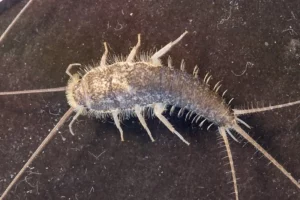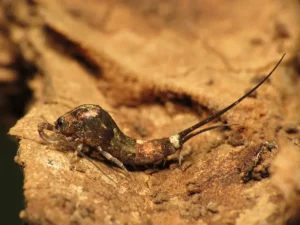There are nine main varieties of silverfish, which are easy to identify and see. Let us explore some types of silverfish below.
- Bristletail silverfish
- Common silverfish
- Four-lined silverfish
- Gray silverfish
- Firebrat silverfish
- Jumping bristletail silverfish
- Ctenolepisma almeriense
- Ctenolepisma ciliatum
- Ctenolepisma guadianicum
Bristletail silverfish
Bristletail is the most prevalent kind of silverfish. They are considered as the sub-type of insect and belong to the class Microcoryphia. They lack wings and have a body that is quite cylindrical. The main food sources for bristletails are algae, mosses, lichens and decaying organic matter.
Common silverfish
Common silverfish is also referred to as Leisma saccharina. The maximum length of this species, a wingless variety of the silverfish, is between 0.5 and 1 inches. These insects live a nocturnal existence, spending the daytime in hiding and avoiding sunlight by being active largely at night. The typical lifespan of a common silverfish is 7 to 8 years.
Four-lined silverfish
The Ctenolepisma quadriseriata, also known as the four-line silverfish, has four black lines on its lower stomach that give birth to its common name of four-lined silverfish. These creatures are a little bit longer than other varieties of silverfish. They mostly consume the cellulose included in paper and other items made of wood pulp as sustenance.
Gray silverfish
The grey silverfish, also known as Ctenolepisma longicaudata, is an insect with a completely grey or dark-colored glossy body that is typically two inches long. The grey silverfish got its name because of its even-toned, gray-colored body. These silverfish require cellulose as a food source, warm temperatures, and humid conditions to mature.

Firebrat silverfish
Thermobia domestica is the scientific name for firebrats. Their bodies are elongated, oblong and often golden in color. These insects prefer environments with high temperatures (of about 90 degrees) for colonisation; these include furnaces and fires. Among all the silverfish, the firebrats are the darkest in color.
Jumping bristletail silverfish
Jumping bristletails is a variety of bristletail silverfish. Their technical name is Pedetontus, but jumping silverfish or leaping bristletails are more frequently used to refer to them in popular culture. These wingless animals seek the protection of debris, stones, boulders and decaying leaves and bark. They consume the cellulose present in dead plants.

Ctenolepisma almeriense
Ctenolepisma almeriense and Ctenolepisma lineatum were earlier regarded as one species due to their similarities. But these two species are different from each other. Ctenolepisma almeriense is not commonly found. It is mostly found in the Mediterranean region of Spain.
Ctenolepisma ciliatum
Silverfish species known as Ctenolepisma ciliatum may be found in several regions of Europe (such as Portugal and the Mediterranean basin) and western Asia. There are several parallels between Ctenolepisma longicaudatum and this primitive lepisma. The body is either grey or brownish in color. The dorsal pattern is iridescent and consistent.
Ctenolepisma guadianicum
Recently, the species of silverfish known as Ctenolepisma guadianicum was discovered. This tiny insect has an elongated body and is less than 1 inch long. This kind of silverfish has long, angled antennae on its head, much like other varieties do. It possesses abdominal appendages as well as six legs. Nevertheless, its body lack any wings.
Examples of Silverfish
- Thysanura
- Nicoletiidae
Conclusion
From the above article, it can be concluded that silverfish have undergone significant evolution and have adjusted to the changes which nature brought.
Also Read:
- Ligase enzyme example
- Insect examples
- Uracil in dna replication
- Do ribosomes make proteins
- Cell without cytoplasm
- Bamboo tree
- Hexapoda characteristics
- Tick characteristics
- Are decomposers biotic or abiotic
- Lyase enzyme example

Hello, I am Bhairavi Rathod, I have completed my Master’s in Biotechnology and qualified ICAR NET 2021 in Agricultural Biotechnology. My area of specialization is Integrated Biotechnology. I have the experience to teach and write very complex things in a simple way for learners.